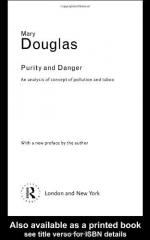
|
| Name: _________________________ | Period: ___________________ |
This test consists of 15 multiple choice questions and 5 short answer questions.
Multiple Choice Questions
1. Why do men and women avoid sex in Lele culture before important events?
(a) It is too pure.
(b) It is pollution.
(c) They do not understand the repercussions.
(d) It is illegal.
2. Douglas claims that primitive cultures have been regarded as manipulating which group of people?
(a) Women.
(b) Elders.
(c) Children.
(d) Men.
3. What do the Dinka people try to control more than other cultures, according to Douglas?
(a) Birth.
(b) Suffering.
(c) Death.
(d) Marriage.
4. What example is given to describe why a sorcerer would move animals to the human sphere?
(a) To exploit them for evil powers.
(b) To consume them in hard times.
(c) To anger God.
(d) To sacrifice the animal's blood.
5. When do Orthodox Brahmins marry off their daughters?
(a) After they begin menstruating.
(b) After puberty.
(c) Before birth.
(d) Before puberty.
6. In Bemba culture, what can cause death?
(a) Fire.
(b) Boundaries.
(c) Lying to an elder.
(d) Sex.
7. What do boundaries represent to Douglas?
(a) Shape.
(b) Religion.
(c) Purity.
(d) Danger.
8. What do the Lele men compete for?
(a) Sex with multiple women.
(b) Homes.
(c) Wives.
(d) Children.
9. What does Douglas describe boundaries as altering?
(a) Religion.
(b) Personality.
(c) Shapes.
(d) Conflicts.
10. Where are the Walbiri from?
(a) Australia.
(b) America.
(c) Britain.
(d) Egypt.
11. What type of barrier crossing is treated as pollution as described by Douglas?
(a) Economic.
(b) Childish.
(c) Social.
(d) Moral.
12. What does Douglas believe maintaining purity stems from in primitive cultures?
(a) Sexuality.
(b) Escapism.
(c) Sin.
(d) Realism.
13. In the Hebrew religion, what could only be touched through sacrifice?
(a) Beef.
(b) Pork.
(c) Blood.
(d) Water.
14. In some tribes, what are examples of formlessness?
(a) Elderly members above the age of 65.
(b) Unborn babies.
(c) Women.
(d) Children under the age of 5.
15. What does the reading state success-based beliefs represent?
(a) Distribution of wealth.
(b) Distribution of purity and pollution.
(c) Distribution of positive power.
(d) Distribution of status.
Short Answer Questions
1. What are Douglas' rules of pollution concerned with?
2. Which of the following do cultures not involve, according to the reading?
3. What types of nationalities are deemed to represent power and invite discrimination, according to Douglas?
4. What do the Nyakusa associate dirt with?
5. What does Douglas think a system needs to be successful?
|
This section contains 356 words (approx. 2 pages at 300 words per page) |

|




